Kristine Hughes's Blog, page 95
March 21, 2014
The Duke of Wellington Tour - Video Highlights - Part Two

Part Two of our video tour of the sites we'll be visiting during The Duke of Wellington Tour in September continues with more on our London stops. We hope you will sign up and come along to share our adventures. After leaving the Tower of London, its on to the Horse Guards and the Household Cavalry Museum.
From the Household Cavalry website:
Perhaps Horse Guards most illustrious tenant, the great Duke of Wellington, the Victor of Waterloo, had two stints at Horse Guards as Commander in Chief, a year from 1827-28 and the last ten years of his life from 1842. His office, formerly the Court Martial Room, is now the office of the Major-General Commanding the Household Division and General Officer Commanding London District. A print shows Wellington receiving visitors at the very same desk which is still in use today, and the decor of the room unchanged. The Duke also had quarters at Horse Guards and what is now an office was once his bedroom with the bed situated under the arch. He had an ensuite closet and a private stairway to the stables below, now blocked off, its entrance used as a cupboard.
We've blogged about the Duke of Wellington's connections to Horse Guards previously and you will find one of those posts by clicking here. You can read about Victoria's previous visit to the Museum here, and one of Kristine's visit to the site here.
You can take a peek inside the Museum here and you can read more about the history of the Household Cavalry here.
For a look at day in the life of a soldier in the Household Cavalry and the training and preparation involved, click here. And here's the link to a stirring video of the Household Cavalry's musical ride at Earls Court in 2012.
Click here to read the story of Sefton, one of the Cavalry's most famous horses who survived an IRA bombing. And on the flip side, you can click here to see video of the naughty Fenton, who led Guards on a merry chase down Whitehall during the wedding of William and Kate. Watch with the sound on so that you can hear a Guard repeatedly calling Fenton - to no avail. All came right in the end, however - Fenton was finally cornered at the Wellington Arch.
You'll find the complete itinerary and further details for The Duke of Wellington Tour in September here.
Published on March 21, 2014 00:00
March 19, 2014
Help - I'm Addicted to Coronation Street!
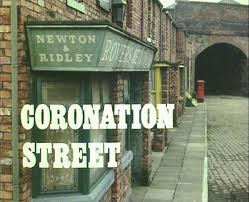
I was trolling around YouTube a couple of weeks ago whilst looking for material for a Video Wednesday post and somehow came upon a vintage episode of Coronation Street - known as "Corrie" to it's fans - from January 3, 1977. Having never actually watched the show, I made the mistake of clicking the link. I watched the espisode and, Reader, I was hooked. Line and sinkered, too. I discovered that YouTube user Auntie Corrie has uploaded years of vintage Coronation Street, which you can find on her playlists. I've been watching episodes daily, which Victoria seems to think is hysterical, mainly because I'm watching episodes of a soap opera that are forty-odd years old.
Coronation Street debuted live on December 9, 1960 and is set in the fictional town of Weatherfield, located just outside of Manchester. What makes Coronation Street so special are it's characters, who lead ordinary, every day lives, have human flaws and are, by turns, endearing, frustrating, snarky, like-able, utterly loathsome, timid, brash, sneaky, golden hearted and always fascinating to watch.
Perhaps the most important character on Coronation Street is the pub called The Rovers Return, usually referred to as The Rovers, which is the hub and heart of the Street.

The Rovers was owned by Annie Walker, below right, and staffed by everyone's favorite barmaid and bottle blonde, Bet Lynch, at left.
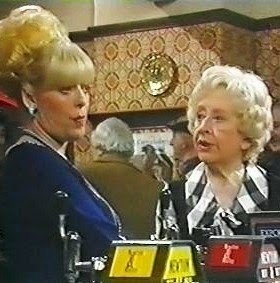
The bar staff were rounded out by Betty and Fred, pictured below.
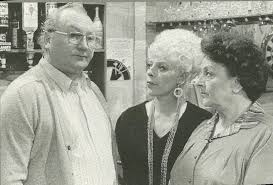
You'll find a complete list of the Rover's landlords and staff from 1960 till today here.

Other residents of the Street included Ena Sharples, who was the caretaker of the community center along with Albert Tatlock, and who spent much of her time criticising the activities of her neighbors. Mrs. Sharples was in the very first episode and spent the next twenty years as a regular cast member, making her final appearance in 1980. Actress Violet Carson received an OBE for her work in 1965.
Then there are Rita (a former exotic dancer) and Len Fairclough, who own a corner store called The Kabin.
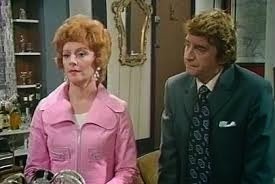
Actress Barbara Knox is still playing Rita to this day. Rita was helped in the shop by the hapless, scatterbrained and unlucky in love Mavis Riley.
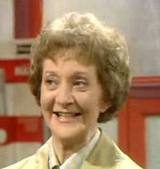
Also in the Street is the Corner Shop, owned by Renee Roberts
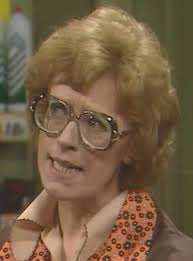
But the biggest employer in the Street has to be Mike Baldwin, factory and shop owner and local lothario
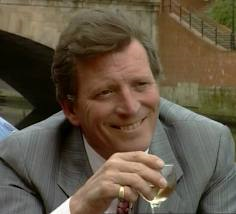
Comic relief is provided by Hilda and Stan, the always battling Ogdens. Stanley is a window washer, while Hilda cleans both at Mike's factory and The Rovers.
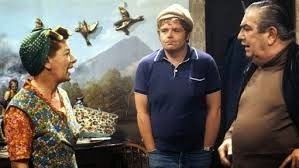
In the background in the photo above can be seen Hilda's "muriel," of which she's very proud. Geoffrey Hughes (Onslow in Keeping Up Appearances) played Stan's mate and petty criminal Eddie Yeats. You can watch a compilation of Hilda and Stan clips here.
Of course, these are but a handful of the Street's residents you'll come to know and love if you should choose (dare?) to tune in. You might become a fan, as well. You'd be in good company - Benedict Cumberbatch is a huge fan of the show and discusses Corrie in this video clip made for the celebration of the show's 50th Birthday. Even the Royals are apparently hooked on the Street. Here are some snaps taken when they visited the set.
Queen Elizabeth opened the new set in the 1982
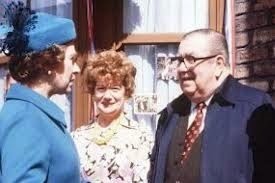


Even Mrs. Thatcher stopped by The Rovers - and raised a glass with the cast

You can watch a montage of 50 years of Coronation Street here.
Click here to see an introduction to the new Corrie set, with a retrospective of the Street from the 1960's through to today. And here's an hour long special called Coronation Street: A Moving Story on how the residents of the Street felt about moving to the new studios and an in-depth, behind the scenes look at the building of the new set, as well as a retrospective of the past fifty years.
I'm off to watch another episode of classic Corrie - I'm up to March, 1980. Only thirty-four years to go!
Published on March 19, 2014 00:00
March 17, 2014
At the Corcoran: Part One, European Works
Victoria here. I recently visited the Corcoran Gallery in Washington D.C. which is facing some big changes in the future, including probable takeover of the collection by the National Gallery of Art and of the College of Art and Design by George Washington University.
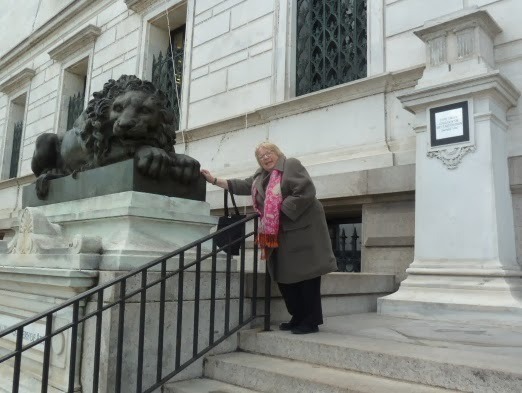 Victoria with one of the Lions guarding the entrancePhoto snapped bv Author Diane Gaston I visited for the first time in many years because of the accounts I had read of the negotiations over the gallery's collection, school, and building. Back when I lived in Washington D.C., I went often so this was a sentimental return as well as curiosity about what is going on. Author Diane Gaston and I walked over after a delicious Peruvian lunch at El Chalan with Julie Halperson, who sadly had to return to work after our chat and feast.
Victoria with one of the Lions guarding the entrancePhoto snapped bv Author Diane Gaston I visited for the first time in many years because of the accounts I had read of the negotiations over the gallery's collection, school, and building. Back when I lived in Washington D.C., I went often so this was a sentimental return as well as curiosity about what is going on. Author Diane Gaston and I walked over after a delicious Peruvian lunch at El Chalan with Julie Halperson, who sadly had to return to work after our chat and feast.
 Julie, Diane and Vicky with a mural behind! Diana and I explored the wonderful galleries and chatted with a few employees and students, all of whom expressed disappointment that the Corcoran would probably not be able to sustain its independence. But nothing is etched into the marble as yet, and the proposed solution to the Corcoran's continuing budget deficits will at least preserve most of the institution's assets, if not its historic status. So the general mood was measured optimism. The Corcoran's website is here.
Julie, Diane and Vicky with a mural behind! Diana and I explored the wonderful galleries and chatted with a few employees and students, all of whom expressed disappointment that the Corcoran would probably not be able to sustain its independence. But nothing is etched into the marble as yet, and the proposed solution to the Corcoran's continuing budget deficits will at least preserve most of the institution's assets, if not its historic status. So the general mood was measured optimism. The Corcoran's website is here.
 View from 17th St, corner of New York Ave. NW
View from 17th St, corner of New York Ave. NW
Here are some shots I took of the European collection, starting in the Mantel Room.
 The Mantel Room, with Houdon busts andpaintings by Gainsborough (left two) and Reynolds, above
The Mantel Room, with Houdon busts andpaintings by Gainsborough (left two) and Reynolds, above
The Corcoran is primarily notable for its American paintings, about which I will also write later. But of course Diane and I were immediately drawn to the British and French works from the 18th and 19th centuries. Observations on the mantel after which the room is named were written by art critic Blake Gopnik here. It apparently has a long and intercontinental history.
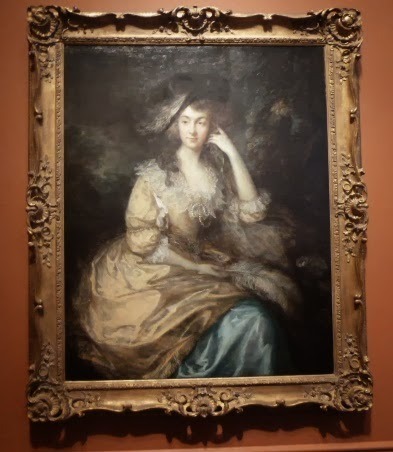 Gainsborough: Frances Susanna, Lady de Dunstanville, c. 1785
Gainsborough: Frances Susanna, Lady de Dunstanville, c. 1785
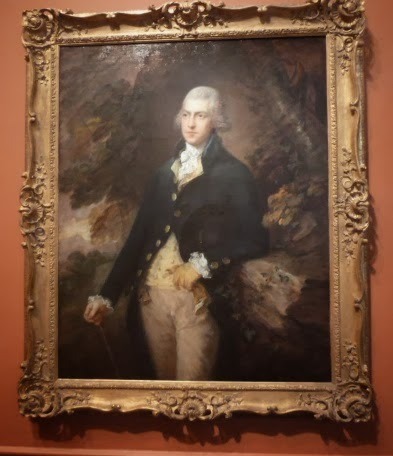 Gainsborough: Francis Basset, Lord de Dunstanville, c. 1786 Thomas Gainsborough (British, 1727-1788) painted this couple from Cornwall in his usual style. Here is an interesting article about the paintings written by Blake Gopnik from the Washington Post several years ago. .
Gainsborough: Francis Basset, Lord de Dunstanville, c. 1786 Thomas Gainsborough (British, 1727-1788) painted this couple from Cornwall in his usual style. Here is an interesting article about the paintings written by Blake Gopnik from the Washington Post several years ago. .
 Reynolds: Annetta, Daughter of Edward Coke, Esq.; wife of Lewis Cage, Esq. of Milgate, Kent, 1758. I will write more about this painting too, as I have had quite an adventure trying to find out more about the subject and the actual painting itself. I will just ease you a bit by saying this lady shows up on the extended family tree of Jane Austen.
Reynolds: Annetta, Daughter of Edward Coke, Esq.; wife of Lewis Cage, Esq. of Milgate, Kent, 1758. I will write more about this painting too, as I have had quite an adventure trying to find out more about the subject and the actual painting itself. I will just ease you a bit by saying this lady shows up on the extended family tree of Jane Austen.  Giuseppe Croff (Italian, 1810–69) The Veiled Nun c. 1860 marble
Giuseppe Croff (Italian, 1810–69) The Veiled Nun c. 1860 marble
For a period of time in the 19th century, sculptures of veiled women executed in marble were very popular. The skills of the artists are obvious and the mysterious ladies always attract attention. This bust was purchased by Gallery founder William Wilson Corcoran in Rome and was part of the gallery's collection from its opening in 1874. Elisabeth Vigée LeBrun, French (1755-1842) Madame du Barry 1782
Elisabeth Vigée LeBrun, French (1755-1842) Madame du Barry 1782
Vigée LeBrun is a renowned painter, one of the few women artists to reach the height of fashion and excellence in her time. She painted many French aristocrats (and those not better than they should be), especially the ill-fated Queen Marie Antoinette. Vigée LeBrun fled France and traveled in Europe, to Russia and to Britain where she extended her popularity. Jeanne Bécu, comtesse du Barry (1743-1793), a mistress of Louis XV, was beheaded in the Reign of Terror. Her story has been often told and re-told in print and in film.
 Jean-Baptiste-Camille Corot French (1796-1875) Le Repos (the Repose), 1860, re-worked 1865-70 Corot, whose beloved landscapes grace more museums than just about anyone's, paints this nude as almost an accessory to the landscape. As the leader of the Barbizon movement, he was, in the words of Wikipedia "...a pivotal figure in landscape painting. His work simultaneously references the Neo-Classical tradition and anticipates the plein-air innovations of Impressionism."
Jean-Baptiste-Camille Corot French (1796-1875) Le Repos (the Repose), 1860, re-worked 1865-70 Corot, whose beloved landscapes grace more museums than just about anyone's, paints this nude as almost an accessory to the landscape. As the leader of the Barbizon movement, he was, in the words of Wikipedia "...a pivotal figure in landscape painting. His work simultaneously references the Neo-Classical tradition and anticipates the plein-air innovations of Impressionism."
 Pierre-Auguste Renoir, French 1841-1919 View from Cap Martin of Monte Carlo, c. 1884 This landscape by Renoir is based on a sketch he made on a Riviera trip with Claude Monet in 1883.
Pierre-Auguste Renoir, French 1841-1919 View from Cap Martin of Monte Carlo, c. 1884 This landscape by Renoir is based on a sketch he made on a Riviera trip with Claude Monet in 1883.
 Rembrandt van Rijn Dutch (1606-1669)Man with a Sheet of Music, 1638 Sorry about the reflection on his hat, but a couldn't find an angle to eliminate it. Rembrandt's work needs no description from me, but this painting is indicative, along with those above, of the kind of works collected by the founders of the collection. Some might call them robber barons, but many of them, both in the U.S. and abroad, left us treasures we have to be thankful for. I wonder of the billionaires of today will do the same for our grandchildren? I will be blogging more about the Corcoran collections soon, including the American works, the Salon Doré, and the fate of the Gallery itself.
Rembrandt van Rijn Dutch (1606-1669)Man with a Sheet of Music, 1638 Sorry about the reflection on his hat, but a couldn't find an angle to eliminate it. Rembrandt's work needs no description from me, but this painting is indicative, along with those above, of the kind of works collected by the founders of the collection. Some might call them robber barons, but many of them, both in the U.S. and abroad, left us treasures we have to be thankful for. I wonder of the billionaires of today will do the same for our grandchildren? I will be blogging more about the Corcoran collections soon, including the American works, the Salon Doré, and the fate of the Gallery itself.
 Victoria with one of the Lions guarding the entrancePhoto snapped bv Author Diane Gaston I visited for the first time in many years because of the accounts I had read of the negotiations over the gallery's collection, school, and building. Back when I lived in Washington D.C., I went often so this was a sentimental return as well as curiosity about what is going on. Author Diane Gaston and I walked over after a delicious Peruvian lunch at El Chalan with Julie Halperson, who sadly had to return to work after our chat and feast.
Victoria with one of the Lions guarding the entrancePhoto snapped bv Author Diane Gaston I visited for the first time in many years because of the accounts I had read of the negotiations over the gallery's collection, school, and building. Back when I lived in Washington D.C., I went often so this was a sentimental return as well as curiosity about what is going on. Author Diane Gaston and I walked over after a delicious Peruvian lunch at El Chalan with Julie Halperson, who sadly had to return to work after our chat and feast. Julie, Diane and Vicky with a mural behind! Diana and I explored the wonderful galleries and chatted with a few employees and students, all of whom expressed disappointment that the Corcoran would probably not be able to sustain its independence. But nothing is etched into the marble as yet, and the proposed solution to the Corcoran's continuing budget deficits will at least preserve most of the institution's assets, if not its historic status. So the general mood was measured optimism. The Corcoran's website is here.
Julie, Diane and Vicky with a mural behind! Diana and I explored the wonderful galleries and chatted with a few employees and students, all of whom expressed disappointment that the Corcoran would probably not be able to sustain its independence. But nothing is etched into the marble as yet, and the proposed solution to the Corcoran's continuing budget deficits will at least preserve most of the institution's assets, if not its historic status. So the general mood was measured optimism. The Corcoran's website is here.
 View from 17th St, corner of New York Ave. NW
View from 17th St, corner of New York Ave. NWHere are some shots I took of the European collection, starting in the Mantel Room.
 The Mantel Room, with Houdon busts andpaintings by Gainsborough (left two) and Reynolds, above
The Mantel Room, with Houdon busts andpaintings by Gainsborough (left two) and Reynolds, aboveThe Corcoran is primarily notable for its American paintings, about which I will also write later. But of course Diane and I were immediately drawn to the British and French works from the 18th and 19th centuries. Observations on the mantel after which the room is named were written by art critic Blake Gopnik here. It apparently has a long and intercontinental history.
 Gainsborough: Frances Susanna, Lady de Dunstanville, c. 1785
Gainsborough: Frances Susanna, Lady de Dunstanville, c. 1785
 Gainsborough: Francis Basset, Lord de Dunstanville, c. 1786 Thomas Gainsborough (British, 1727-1788) painted this couple from Cornwall in his usual style. Here is an interesting article about the paintings written by Blake Gopnik from the Washington Post several years ago. .
Gainsborough: Francis Basset, Lord de Dunstanville, c. 1786 Thomas Gainsborough (British, 1727-1788) painted this couple from Cornwall in his usual style. Here is an interesting article about the paintings written by Blake Gopnik from the Washington Post several years ago. .  Reynolds: Annetta, Daughter of Edward Coke, Esq.; wife of Lewis Cage, Esq. of Milgate, Kent, 1758. I will write more about this painting too, as I have had quite an adventure trying to find out more about the subject and the actual painting itself. I will just ease you a bit by saying this lady shows up on the extended family tree of Jane Austen.
Reynolds: Annetta, Daughter of Edward Coke, Esq.; wife of Lewis Cage, Esq. of Milgate, Kent, 1758. I will write more about this painting too, as I have had quite an adventure trying to find out more about the subject and the actual painting itself. I will just ease you a bit by saying this lady shows up on the extended family tree of Jane Austen.  Giuseppe Croff (Italian, 1810–69) The Veiled Nun c. 1860 marble
Giuseppe Croff (Italian, 1810–69) The Veiled Nun c. 1860 marble For a period of time in the 19th century, sculptures of veiled women executed in marble were very popular. The skills of the artists are obvious and the mysterious ladies always attract attention. This bust was purchased by Gallery founder William Wilson Corcoran in Rome and was part of the gallery's collection from its opening in 1874.
 Elisabeth Vigée LeBrun, French (1755-1842) Madame du Barry 1782
Elisabeth Vigée LeBrun, French (1755-1842) Madame du Barry 1782 Vigée LeBrun is a renowned painter, one of the few women artists to reach the height of fashion and excellence in her time. She painted many French aristocrats (and those not better than they should be), especially the ill-fated Queen Marie Antoinette. Vigée LeBrun fled France and traveled in Europe, to Russia and to Britain where she extended her popularity. Jeanne Bécu, comtesse du Barry (1743-1793), a mistress of Louis XV, was beheaded in the Reign of Terror. Her story has been often told and re-told in print and in film.
 Jean-Baptiste-Camille Corot French (1796-1875) Le Repos (the Repose), 1860, re-worked 1865-70 Corot, whose beloved landscapes grace more museums than just about anyone's, paints this nude as almost an accessory to the landscape. As the leader of the Barbizon movement, he was, in the words of Wikipedia "...a pivotal figure in landscape painting. His work simultaneously references the Neo-Classical tradition and anticipates the plein-air innovations of Impressionism."
Jean-Baptiste-Camille Corot French (1796-1875) Le Repos (the Repose), 1860, re-worked 1865-70 Corot, whose beloved landscapes grace more museums than just about anyone's, paints this nude as almost an accessory to the landscape. As the leader of the Barbizon movement, he was, in the words of Wikipedia "...a pivotal figure in landscape painting. His work simultaneously references the Neo-Classical tradition and anticipates the plein-air innovations of Impressionism."
 Pierre-Auguste Renoir, French 1841-1919 View from Cap Martin of Monte Carlo, c. 1884 This landscape by Renoir is based on a sketch he made on a Riviera trip with Claude Monet in 1883.
Pierre-Auguste Renoir, French 1841-1919 View from Cap Martin of Monte Carlo, c. 1884 This landscape by Renoir is based on a sketch he made on a Riviera trip with Claude Monet in 1883. Rembrandt van Rijn Dutch (1606-1669)Man with a Sheet of Music, 1638 Sorry about the reflection on his hat, but a couldn't find an angle to eliminate it. Rembrandt's work needs no description from me, but this painting is indicative, along with those above, of the kind of works collected by the founders of the collection. Some might call them robber barons, but many of them, both in the U.S. and abroad, left us treasures we have to be thankful for. I wonder of the billionaires of today will do the same for our grandchildren? I will be blogging more about the Corcoran collections soon, including the American works, the Salon Doré, and the fate of the Gallery itself.
Rembrandt van Rijn Dutch (1606-1669)Man with a Sheet of Music, 1638 Sorry about the reflection on his hat, but a couldn't find an angle to eliminate it. Rembrandt's work needs no description from me, but this painting is indicative, along with those above, of the kind of works collected by the founders of the collection. Some might call them robber barons, but many of them, both in the U.S. and abroad, left us treasures we have to be thankful for. I wonder of the billionaires of today will do the same for our grandchildren? I will be blogging more about the Corcoran collections soon, including the American works, the Salon Doré, and the fate of the Gallery itself.
Published on March 17, 2014 00:00
March 14, 2014
The Duke of Wellington Tour - Video Highlights - Part One

Over the next few weeks, we'll be bringing you video of the places we'll be visiting on The Duke of Wellington Tour in September. Today, we begin with our first stop - London.

The Grosvenor Hotel, Victoria, above, where our journey begins.
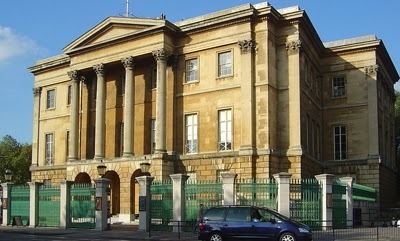
Apsley House, the first stop on our tour, where our group will be given a private, guided tour of the property.
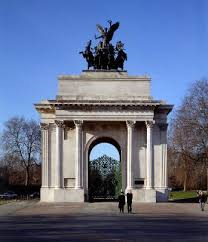
Afterwards, we'll visit the Wellington Arch.
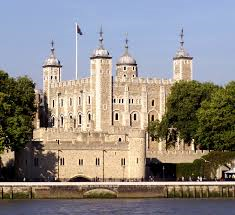
We'll then proceed by private motor coach to the Tower of London, where we'll see the exhibition being mounted to illustrate the Duke of Wellington's influence upon the Tower in the capacities of both Constable of the Tower and Prime Minister. Here's a video that provides some background on the office of Constable, as well as Wellington's influence on the Tower. We'll also be meeting with the Ravenmaster of the Tower, who regularly posts amusing pictures of his charges on Twitter.

You can find the complete itinerary and pricing for The Duke of Wellington Tour here.
Published on March 14, 2014 00:00
March 12, 2014
Do You Know About . . . . . . Victorian Farm?
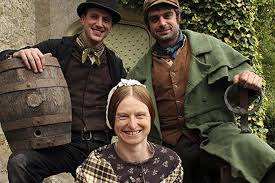
Amazingly enough, I only discovered the six part documentary called Victorian Farm when I was trolling around Youtube recently. The show follows three modern day people spending a year as Victorian farmers in Shropshire and originally ran for six episodes in 2009.
From the BBC website:
"Historical observational documentary series following a team who live the life of Victorian farmers for a year. Wearing period clothes and using only the materials that would have been available in 1885, historian Ruth Goodman and archaeologists Alex Langlands and Peter Ginn are going back in time to relive the day-to-day life of the Victorian farmer.
"The project is based on the Acton Scott estate in Shropshire - a world frozen in time, lost in Victorian rural England. Its buildings and grounds are cluttered with antique tools and machinery collected by the Acton family, who have lived on the estate since the 12th century.
"Working for a full calendar year, Ruth, Alex and Peter are rediscovering a lost world of skills, crafts and knowledge, assisted by an ever-dwindling band of experts who keep Victorian rural practices alive.
The team move into a Victorian smallholding on the Acton Scott estate that has not been used in nearly half a century. Their first task is the restoration of the cottage. As incoming tenants, they help thresh the previous summer's wheat crop, their first experience of steam-powered machinery. Alex attempts to sow a wheat crop using horse-power. Ruth and Peter install a range in the cottage and take a trip to the canals to load up on coal. It's time for the apple harvest, so Alex and Peter turn their hand to making cider. Ruth explores the challenges of Victorian cooking by making preserves ready for winter and cooks her first meal on the range. And the team must learn shepherding skills the hard way as the first livestock arrive on the farm - a flock of Shropshire ewes."
I adore this series, as watching it is a bit like getting a private history lesson - housewifery and animal husbandry are brought to life along with nearly forgotten crafts, skills and traditions. Here's the link to the first episode.
Because of viewer response to the series, the BBC went on to film Edwardian Farm and Victorian Pharmacy, followed by War Time Farm, all three series also featuring Ruth, Alex and Peter. These should hold you for a few weeks, at the very least - enjoy!
Published on March 12, 2014 00:00
March 10, 2014
Waving the Flag...
Victoria here. I recently visited Fort McHenry in Baltimore, MD, where after a bombardment by the British Navy in 1814, American writer Francis Scott Key (1779–1843) wrote the words to the Star Spangled Banner, which became the American national anthem.
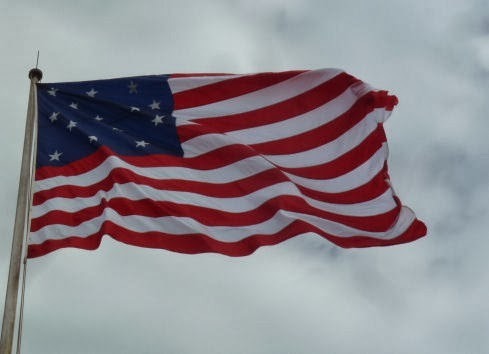 Ft. McHenry's 15-star and stripe flag of 1814 (in use from 1795-1818) Now, the flag of the USA has thirteen red and white stripes, representing the original 13 British colonies, and fifty stars, representing the 50 states of the union.
Ft. McHenry's 15-star and stripe flag of 1814 (in use from 1795-1818) Now, the flag of the USA has thirteen red and white stripes, representing the original 13 British colonies, and fifty stars, representing the 50 states of the union.

The Grand Union Flag was used from December 1775 to June 1777, incorporating the thirteen stripes for the 13 colonies and the British Union Jack.
Later there were several versions of the flag with thirteen red and white stripes and thirteen stars on a the latter either on a blue field in rows or in a circle.
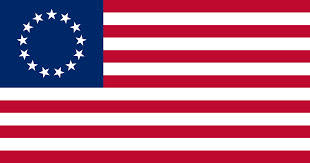 Often called the Betsy Ross Flag
Often called the Betsy Ross Flag
There have been many, many U.S. flags over the years. Then I got to wondering where the Maryland State Flag came from, as it has a quite unique design. Turns out it is based on the heraldic arms of the founding family of the colony of Maryland, the Calverts, Barons Baltimore, incorporating the arms of the Crossland family as well. According to Wikipedia, it is the only state flag that is based on English heraldry.
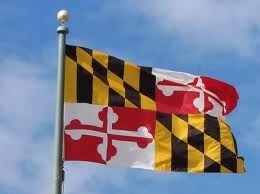 Maryland flag However, the Flag of the District of Columbia, is based on the family crest of the Washington family of County Durham, England, originating in the 12th century.
Maryland flag However, the Flag of the District of Columbia, is based on the family crest of the Washington family of County Durham, England, originating in the 12th century.

District of Columbia Flag, adopted in 1938 Below the arms of the Washington Family, in a 14th C. window of the Selby Abbey in Yorkshire.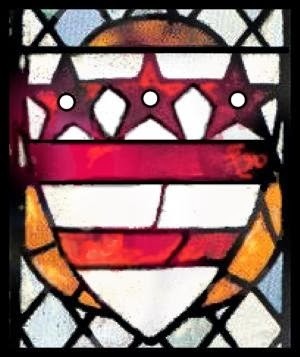 Who knew???
Who knew???
 Ft. McHenry's 15-star and stripe flag of 1814 (in use from 1795-1818) Now, the flag of the USA has thirteen red and white stripes, representing the original 13 British colonies, and fifty stars, representing the 50 states of the union.
Ft. McHenry's 15-star and stripe flag of 1814 (in use from 1795-1818) Now, the flag of the USA has thirteen red and white stripes, representing the original 13 British colonies, and fifty stars, representing the 50 states of the union.

The Grand Union Flag was used from December 1775 to June 1777, incorporating the thirteen stripes for the 13 colonies and the British Union Jack.
Later there were several versions of the flag with thirteen red and white stripes and thirteen stars on a the latter either on a blue field in rows or in a circle.
 Often called the Betsy Ross Flag
Often called the Betsy Ross FlagThere have been many, many U.S. flags over the years. Then I got to wondering where the Maryland State Flag came from, as it has a quite unique design. Turns out it is based on the heraldic arms of the founding family of the colony of Maryland, the Calverts, Barons Baltimore, incorporating the arms of the Crossland family as well. According to Wikipedia, it is the only state flag that is based on English heraldry.
 Maryland flag However, the Flag of the District of Columbia, is based on the family crest of the Washington family of County Durham, England, originating in the 12th century.
Maryland flag However, the Flag of the District of Columbia, is based on the family crest of the Washington family of County Durham, England, originating in the 12th century.

District of Columbia Flag, adopted in 1938 Below the arms of the Washington Family, in a 14th C. window of the Selby Abbey in Yorkshire.
 Who knew???
Who knew???
Published on March 10, 2014 00:00
March 7, 2014
The Duke of Wellington Tour: St. James's Palace
On Sunday, September 5, 2014, the lucky participants in The Duke of Wellington Tour will take a walking tour (aka a leisurely stroll with many stops for refreshment) of part of London, principally through St. James's. Victoria here, with a few facts and pictures.
St. James's can mean a number of things in London, but generally it refers to a small neighborhood south of Mayfair and west of Whitehall and Trafalgar square, bounded by Piccadilly on the north, St James's Park on the south, Green Park on the west and Haymarket on the east. St. James's is a royal palace; a church on Piccadilly, designed by Sir Christopher Wren; a lovely park; an area known as clubland, and a street of distinguished shops.
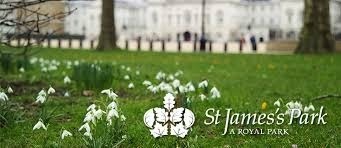
The name comes from St. James's Palace, so named because it was built on the site of a hospital for lepers dedicated to St. James the Less, one of the twelve Apostles. Here Henry VIII built the red brick structure which still serves as the official residence of the British monarch. Note that Ambassadors to Great Britain are officially designated as Ambassadors to the Court of St. James.
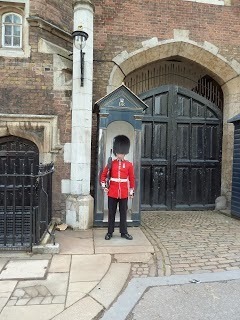 Main Entrance on Pall Mallat the foot of St. James's Street
Main Entrance on Pall Mallat the foot of St. James's Street
 The Tudor Entrance
The Tudor Entrance
Official events are held here and the Chapel Royal is often the venue for royal weddings and baptisms, such as the christening of Prince George of Cambridge on October 13, 2013.
 Prince William, Duke of Cambridge, the Duchess of Cambridge and Prince George of Cambridge at St James's Palace for the Christening
Prince William, Duke of Cambridge, the Duchess of Cambridge and Prince George of Cambridge at St James's Palace for the Christening
 The Altar, Chapel Royal, from The Mirrorfor more pictures of the Chapel Royal, click here. St. James's Palace is not open to the public, though it is possible to attend some Sunday worship services at the Chapel Royal from October to Good Friday. Click here for details.
The Altar, Chapel Royal, from The Mirrorfor more pictures of the Chapel Royal, click here. St. James's Palace is not open to the public, though it is possible to attend some Sunday worship services at the Chapel Royal from October to Good Friday. Click here for details.
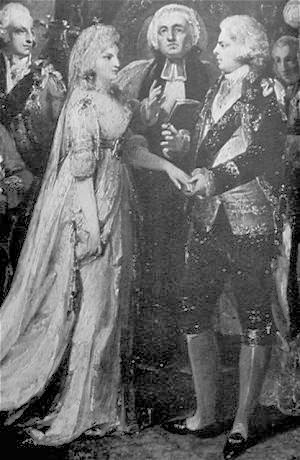 Caroline and George The ill-fated wedding of George, Prince of Wales (later George IV) to Princess Caroline of Brunswick took place on April 8, 1795.
Caroline and George The ill-fated wedding of George, Prince of Wales (later George IV) to Princess Caroline of Brunswick took place on April 8, 1795.
 Albert and Queen Victoria Queen Victoria married Prince Albert of Saxe-Coburg-Gotha on February 10, 1840 in the Chapel Royal. Eighteen years later, their daughter Victoria, The Princess Royal, married here as well, to the future German Emperor Frederick III.
Albert and Queen Victoria Queen Victoria married Prince Albert of Saxe-Coburg-Gotha on February 10, 1840 in the Chapel Royal. Eighteen years later, their daughter Victoria, The Princess Royal, married here as well, to the future German Emperor Frederick III.
 The Marriage of George V and Princess Mary of Teck, July 6, 1893
The Marriage of George V and Princess Mary of Teck, July 6, 1893
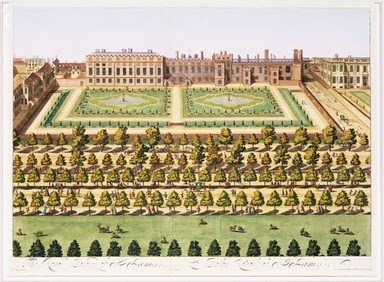 Gardens at St. James's, ca. 1700
Gardens at St. James's, ca. 1700
According to the Garden Visit website (click here), the original renaissance garden, shown above, compartments, were re-designed in the "gardenesque style."
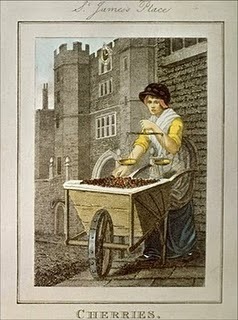 18th Century Print: Cherries; a seller outside the Palace St. James's has often been the venue for Royal levees and receptions . This plate below from the Microcosm of London, 1810, shows a "Drawing Room," where a chosen circle could present themselves and their friends and family formally to the Royals.
18th Century Print: Cherries; a seller outside the Palace St. James's has often been the venue for Royal levees and receptions . This plate below from the Microcosm of London, 1810, shows a "Drawing Room," where a chosen circle could present themselves and their friends and family formally to the Royals.
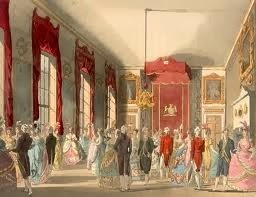 Ackermann's Microcosm of London On the Duke of Wellington Tour, we won't be going inside, but we will see the Palace and its neighbors, The Queen's Chapel, Marlborough House, Lancaster House, Clarence House, the Mall, St. James's Street, and more. Below are a few pictures I took on a previous visit to St. James's.
Ackermann's Microcosm of London On the Duke of Wellington Tour, we won't be going inside, but we will see the Palace and its neighbors, The Queen's Chapel, Marlborough House, Lancaster House, Clarence House, the Mall, St. James's Street, and more. Below are a few pictures I took on a previous visit to St. James's.
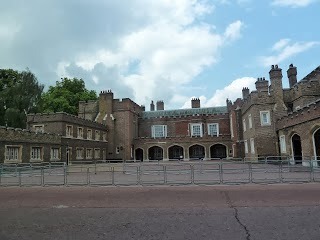 Palace from Marlborough Road
Palace from Marlborough Road
 Palace from Marlborough Road
Palace from Marlborough Road
 The Queens Chapel in Marlborough Road
The Queens Chapel in Marlborough Road
 Along the Mall, Trooping of the Colour, 2011
Along the Mall, Trooping of the Colour, 2011
 Marlborough House
Marlborough House
 St. James's Church, Piccadilly For all the Details about The Duke of Wellington Tour, click here.
St. James's Church, Piccadilly For all the Details about The Duke of Wellington Tour, click here.
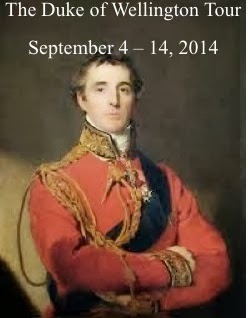
St. James's can mean a number of things in London, but generally it refers to a small neighborhood south of Mayfair and west of Whitehall and Trafalgar square, bounded by Piccadilly on the north, St James's Park on the south, Green Park on the west and Haymarket on the east. St. James's is a royal palace; a church on Piccadilly, designed by Sir Christopher Wren; a lovely park; an area known as clubland, and a street of distinguished shops.

The name comes from St. James's Palace, so named because it was built on the site of a hospital for lepers dedicated to St. James the Less, one of the twelve Apostles. Here Henry VIII built the red brick structure which still serves as the official residence of the British monarch. Note that Ambassadors to Great Britain are officially designated as Ambassadors to the Court of St. James.
 Main Entrance on Pall Mallat the foot of St. James's Street
Main Entrance on Pall Mallat the foot of St. James's Street
 The Tudor Entrance
The Tudor Entrance Official events are held here and the Chapel Royal is often the venue for royal weddings and baptisms, such as the christening of Prince George of Cambridge on October 13, 2013.
 Prince William, Duke of Cambridge, the Duchess of Cambridge and Prince George of Cambridge at St James's Palace for the Christening
Prince William, Duke of Cambridge, the Duchess of Cambridge and Prince George of Cambridge at St James's Palace for the Christening
 The Altar, Chapel Royal, from The Mirrorfor more pictures of the Chapel Royal, click here. St. James's Palace is not open to the public, though it is possible to attend some Sunday worship services at the Chapel Royal from October to Good Friday. Click here for details.
The Altar, Chapel Royal, from The Mirrorfor more pictures of the Chapel Royal, click here. St. James's Palace is not open to the public, though it is possible to attend some Sunday worship services at the Chapel Royal from October to Good Friday. Click here for details.
 Caroline and George The ill-fated wedding of George, Prince of Wales (later George IV) to Princess Caroline of Brunswick took place on April 8, 1795.
Caroline and George The ill-fated wedding of George, Prince of Wales (later George IV) to Princess Caroline of Brunswick took place on April 8, 1795.
 Albert and Queen Victoria Queen Victoria married Prince Albert of Saxe-Coburg-Gotha on February 10, 1840 in the Chapel Royal. Eighteen years later, their daughter Victoria, The Princess Royal, married here as well, to the future German Emperor Frederick III.
Albert and Queen Victoria Queen Victoria married Prince Albert of Saxe-Coburg-Gotha on February 10, 1840 in the Chapel Royal. Eighteen years later, their daughter Victoria, The Princess Royal, married here as well, to the future German Emperor Frederick III.
 The Marriage of George V and Princess Mary of Teck, July 6, 1893
The Marriage of George V and Princess Mary of Teck, July 6, 1893 Gardens at St. James's, ca. 1700
Gardens at St. James's, ca. 1700According to the Garden Visit website (click here), the original renaissance garden, shown above, compartments, were re-designed in the "gardenesque style."
 18th Century Print: Cherries; a seller outside the Palace St. James's has often been the venue for Royal levees and receptions . This plate below from the Microcosm of London, 1810, shows a "Drawing Room," where a chosen circle could present themselves and their friends and family formally to the Royals.
18th Century Print: Cherries; a seller outside the Palace St. James's has often been the venue for Royal levees and receptions . This plate below from the Microcosm of London, 1810, shows a "Drawing Room," where a chosen circle could present themselves and their friends and family formally to the Royals. Ackermann's Microcosm of London On the Duke of Wellington Tour, we won't be going inside, but we will see the Palace and its neighbors, The Queen's Chapel, Marlborough House, Lancaster House, Clarence House, the Mall, St. James's Street, and more. Below are a few pictures I took on a previous visit to St. James's.
Ackermann's Microcosm of London On the Duke of Wellington Tour, we won't be going inside, but we will see the Palace and its neighbors, The Queen's Chapel, Marlborough House, Lancaster House, Clarence House, the Mall, St. James's Street, and more. Below are a few pictures I took on a previous visit to St. James's. Palace from Marlborough Road
Palace from Marlborough Road Palace from Marlborough Road
Palace from Marlborough Road
 The Queens Chapel in Marlborough Road
The Queens Chapel in Marlborough Road
 Along the Mall, Trooping of the Colour, 2011
Along the Mall, Trooping of the Colour, 2011
 Marlborough House
Marlborough House
 St. James's Church, Piccadilly For all the Details about The Duke of Wellington Tour, click here.
St. James's Church, Piccadilly For all the Details about The Duke of Wellington Tour, click here.
Published on March 07, 2014 00:00
March 5, 2014
And From Elsewhere On The Web . . . . .

Regency History - The Print Room at Queen Charlotte's Cottage, Kew
Discovering London - Bird's eye view maps of Victorian London
Blog for the Immortal American Series - A Regency Palette - popular Regency fashion colours
Sir John Soane's Museum - Adam's London: Then and Now - Carlton House, Pall Mall
Past Horizons: Adventures in Archaeology - The Archaeology of a Dress
Downton Abbey Cooks - Mrs. Patmore's Infamous Raspberry Meringue Pudding
The Art of Mourning - The Hair Work Collection
Royal Central - Palace moves to UK Destinations - Visiting stately homes on horseback
C18th Girl - Law enforcement and the criminal courts - Yorkshire 1718-1775
Published on March 05, 2014 00:00
March 4, 2014
A Million Thanks!
WE'VE JUST PASSED
A MILLION PAGEVIEWS!
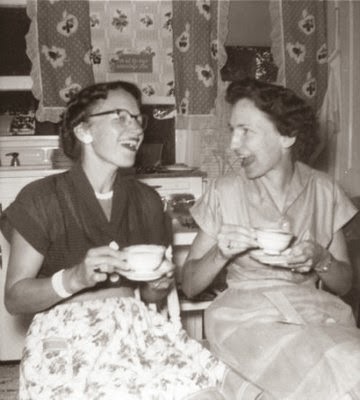
Victoria and Kristine thank you for your continued interest and support of this blog. Obviously, we couldn't have done it without you!
For more and varied content, please visit our other sites:
Victoria on Pinterest
Kristine on Pinterest
The Duke of Wellington Tour
Published on March 04, 2014 00:00
March 3, 2014
2014: The Year of the Bus
That familiar urban creature, the humble bus, is the object of the London Transport Museum's celebration in 2014. Their website is here.

I doubt any visitors to London leave the metropolis without riding the bus, especially one of those open tops that stop at all the familiar sites as they wend their way through the heavy traffic.

The poster below was chosen to represent this stellar event. We have yet to decipher all the images. How about you? Nevertheless it is colorful and expressive.
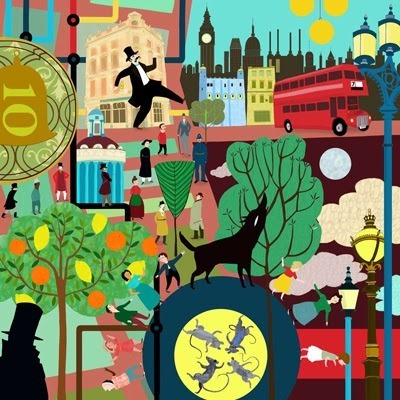
A fascinating aspect of the Year of the Bus is the 100th anniversary of the use of London Buses at the front in World War I. Read more here. Introduced in 1910, this first mass-produced bus was in widespread use in London by the outbreak of the war, and a perfect vehicle for transporting troops.
Read the article about the restoration in the Daily Express here.
 London Transport Museum photo
London Transport Museum photo
The Transport Museum has an excellent collection of old posters -- and here is one of the favorites -- all the London toffs mixing with the hoi polloi as they travel the tube.
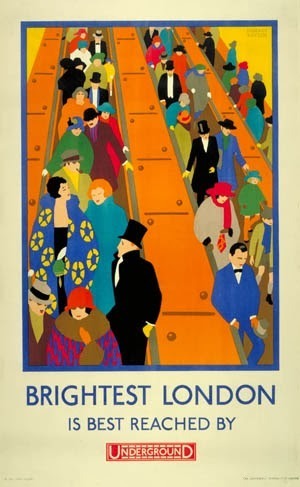

I doubt any visitors to London leave the metropolis without riding the bus, especially one of those open tops that stop at all the familiar sites as they wend their way through the heavy traffic.

The poster below was chosen to represent this stellar event. We have yet to decipher all the images. How about you? Nevertheless it is colorful and expressive.

A fascinating aspect of the Year of the Bus is the 100th anniversary of the use of London Buses at the front in World War I. Read more here. Introduced in 1910, this first mass-produced bus was in widespread use in London by the outbreak of the war, and a perfect vehicle for transporting troops.
Read the article about the restoration in the Daily Express here.
 London Transport Museum photo
London Transport Museum photoThe Transport Museum has an excellent collection of old posters -- and here is one of the favorites -- all the London toffs mixing with the hoi polloi as they travel the tube.

Published on March 03, 2014 00:00
Kristine Hughes's Blog
- Kristine Hughes's profile
- 6 followers
Kristine Hughes isn't a Goodreads Author
(yet),
but they
do have a blog,
so here are some recent posts imported from
their feed.



